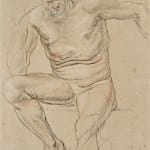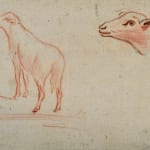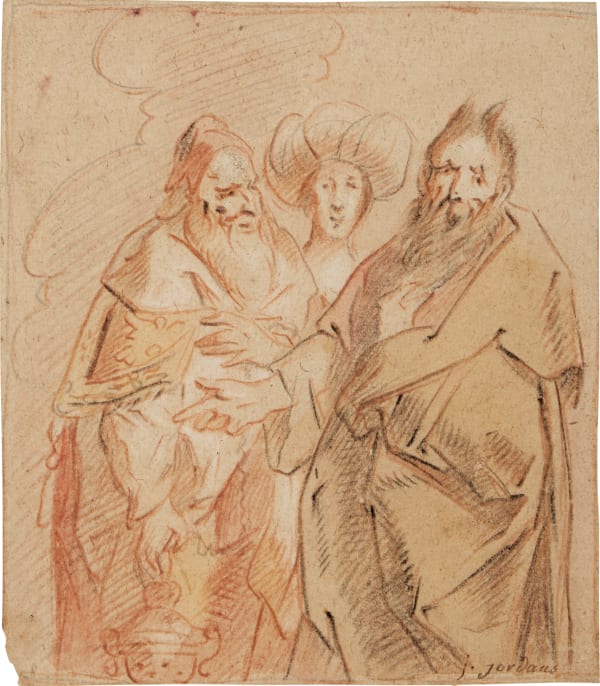Jacob Jordaens (Antwerp 1593 - 1678)
Jacob (or Jacques) Jordaens was born in Antwerp in 1593. Little is known about his early life. At age fourteen he became an apprentice of Adam van Noort, who had also taught painters like Sebastiaen Vrancx and Peter Paul Rubens. He stayed with van Noort for eight years and joined the Guild of St Luke as a "waterpainter" in 1615. The following year he married van Noort's daughter Anna Catharina. The couple had three children, one of whom, Jacob II, went on to become a painter himself.
Jordaens' clientele consisted mostly of well-to-do burghers and clergymen, although after the death of Rubens and van Dyck he was given several courtly commissions too, including a set of eight paintings for Charles I of England and a series of commissions for Christina of Sweden. He also producted numerous designs for tapestries. Apart from a few trips up in the Northern Netherlands, Jordaens lived in worked in Antwerp his whole life. He became a wealthy man and was a prolific artist, remaining productive until the end of his life. Between 1621 and 1667 the records lists fifteen official pupils, but the actual number of students and assistants that passed through his studio must have been much higher, especially given his big output of often large-scale works.
Stylistically, Jordaens was enormously influenced by Rubens, especially in his early work, although the influence of Italian painters such as Veronese and Barocci - who he studied through prints and copies, having never been to Italy - can also readily be felt, for instance in his use of vibrant colours. Until about 1618 his work clearly shows a mannerist touch. Caravaggism certainly also left its mark on his artistic development, as did the work by his contemporary Abraham Janssens. Gradually, Jordaens developed a style that was more his own, fusing the monumental figures of Rubens and Janssens with the brilliant colours of the Italians, combined with a sense of realism. Later on, his figures became somewhat more crudely painted, his compositions marked by a folksy exuberance and a more restriced, darker colour palette. From the 1650's onwards, the quality of his work deteriorates visibly; his later work often shows crowded compositions - albeit with less monumental figures - and at times an almost monochrome use of colour, often restricting himself to thinly applied blue-grey or earth tones.
Jordaens was a somewhat gifted portrait painter, who also produced religious, mythological and history paintings as well as illustrations of Flemish proverbs. He is especially famous for the latter, following in the footsteps of Pieter Bruegel the Elder's genre tradition, honestly depicting Flemish life with authenticity and showing common people in the act of celebratory expressions of life. These humourous, albeit sometimes also somewhat coarse pictures, are among his best known work. Jordaens also etched a number of plates and was a prolific draughtsman, producing many excellent drawings either as preparatory sketches or as work of art in their own right.
This drawing, not recorded in print or reproduced since the catalogue of the 1907 sale (see Provenance), is a new addition to three groups of important nude studies by Jordaens, all depicting middle-aged or older men (for a recent discussion, see N. Van Hout in Jordaens et l’antiquité, exhib. cat., Brussels, Musées Royaux des Beaux-Arts de Belgique, and Kassel, Museumslandschaft Hessen Kassel, 2012-2013, pp. 54-59, nos. 18-27, ill.). The majority can be dated to the 1620s, early in the artist’s career, and are divided between the collections of the Museum Kunstpalast in Düsseldorf and the Hessisches Landesmuseum Darmstadt (R.-A. d’Hulst, Jordaens Drawings, Brussels, 1974, I, nos. A8-A20, III, figs. 8-20); an additional sheet is at the British Museum (inv. Gg,2.228; see ibid., I, no. A21, III, fig. 21). All seem to depict the same strong, bearded and curly-haired man. Of the same model, but markedly superior than the drawings in Darmstadt, Düsseldorf and London, is a sheet in a private collection that was sold at Christie’s, New York, 26 January 2011, lot 282.
Provenance
Marquis Charles-Ferdinand-Louis de Valori, Paris (1820-1883), Paris (L. 2500);
Hôtel Drouot, Paris, 25-26 November 1907, lot 136 (80 fcs to Mathey);
Henry Nanteuil de La Norville (1876-1941), thence by descent.
Literature
To be published by Dr. Stijn Alsteens.- X
- Tumblr
-
 Jacob Jordaens (Antwerp 1593 - 1678)A Still LifeSanguine, black chalk, heightened with white, on laid paper177 x 360 mm
Jacob Jordaens (Antwerp 1593 - 1678)A Still LifeSanguine, black chalk, heightened with white, on laid paper177 x 360 mm -
 Jacob Jordaens (Antwerp 1593 - 1678)Three Studies of a Man in a Jester's Hoodblack chalk and sanguine on laid paper215 x 160 mm
Jacob Jordaens (Antwerp 1593 - 1678)Three Studies of a Man in a Jester's Hoodblack chalk and sanguine on laid paper215 x 160 mm -
 Jacob Jordaens (Antwerp 1597 - 1678)Moses, Aaron and Miriamblack chalk, sanguine and brown wash on laid paper170 x 148 mminscribed 'j. Jordans', lower right
Jacob Jordaens (Antwerp 1597 - 1678)Moses, Aaron and Miriamblack chalk, sanguine and brown wash on laid paper170 x 148 mminscribed 'j. Jordans', lower right -
 Jacob Jordaens (Antwerp 1593 - 1678)Three Portrait Studies of a Man in a Jester's Hood, ca. 1640black chalk and sanguine on laid paper215 x 160 mm
Jacob Jordaens (Antwerp 1593 - 1678)Three Portrait Studies of a Man in a Jester's Hood, ca. 1640black chalk and sanguine on laid paper215 x 160 mm -
 Jacob Jordaens (Antwerp 1597 - 1678)Moses addressing Aaron and Miriamblack chalk, sanguine and brown wash on laid paper170 x 148 mminscribed 'j. Jordans', lower right
Jacob Jordaens (Antwerp 1597 - 1678)Moses addressing Aaron and Miriamblack chalk, sanguine and brown wash on laid paper170 x 148 mminscribed 'j. Jordans', lower right







